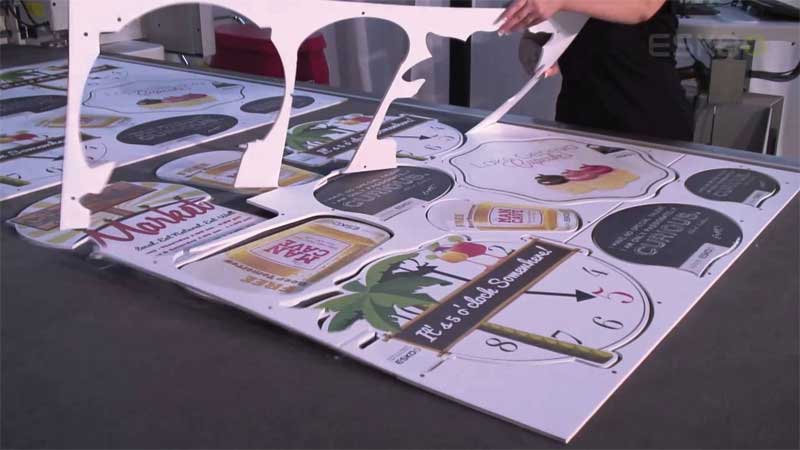Wide-format Graphics: The benefits of signmaking software
by all | 3 August 2017 10:00 am
 [1]
[1]Photos courtesy Esko
By Peter Saunders
Most sign shops use mainstream design software to check and correct their incoming wide-format graphic files and make them print-ready. Software that is not industry-specific, however, lacks much of the dedicated functionality needed to produce signage quickly and efficiently.
A better option is to use tools developed especially for the production of signs and graphics, as these can streamline production from file preparation to printing to finishing. The following are a few examples of specialized functions to look for:
Preflighting
Advanced software for preflighting Portable Document Format (PDF) files can report any problems automatically, before the files go to the printer. There is no need for the user to manually engage the software to figure out why an image will not print properly.
Similarly, multi-page PDF files should be easily edited, whether converting red, green and blue (RGB) image data to the cyan, magenta, yellow and key/black (CMYK) colour space, substituting lower-resolution images or adjusting boundary boxes.
Extending graphics
For banners, flags and other textile-based applications, graphics often need to be extended to (a) compensate for deformation of the substrate during printing or (b) to add a printed hem.
In signmaking software, this can be done quickly by mirroring the image data. This is even possible with double-sided graphics.
 [2]
[2]‘Nesting’ is the optimization of layout for multiple images within a print job, to help minimize waste.
Grommet marks
Grommet marks, too, can be automatically laid out for textile-based graphics before they are printed and finished. Attempting to accomplish the same function manually in desktop design software not only takes a lot of time, but is also prone to errors.
Nesting
‘Nesting’ is the optimization of layout for multiple images within a print job, so as to minimize substrate waste. While the nesting of rectangular shapes is generally not a major challenge for the manual desktop software user, fitting a myriad of irregularly shaped graphics within a panel can be much harder.
With specialized software automating this step, any job can be quickly laid out in the most economical way, based on each image’s unique shape and cutting contours. This substantially reduces pre-press, production and finishing time.
Also, as with the extending of graphics, signmaking software can handle nesting for double-sided graphic jobs automatically, synchronizing the front and back designs.
 [3]
[3]Cutting paths can be created well before the graphics reach the finishing department.
Tiling
The opposite of nesting is tiling, whereby an oversized job—such as a billboard—must be printed and cut as a series of pieces, which are then assembled for installation.
With software designed for the sign industry, irregular tiles can be defined for special applications like wall murals, exhibition booths and large in-store displays. And by storing the tiling schemes for these applications in a computer, as graphic design templates, the preparation time for future jobs is dramatically shortened. An assembly report can be compiled to facilitate mounting.
Cutting paths
Industry-specific layout functionality in signmaking software allows the user to create and clean up the cutting paths for wide-format graphic files before they reach the finishing department. What would take hours of tedious, cumbersome, manual layout work in standard desktop graphic design software can now be done much faster with the right tools.
Automatic bleed generation
When the cutting contour is set exactly on the edge of a graphic, there is the risk of a false registration between the printer and the cutter leaving an unseemly white line. With automatic bleed generation, however, this problem is avoided, saving time. Signmaking software can even clone image pixels when there is no data available outside the cut contour itself.
Print-and-cut files
Given all of the aforementioned examples, it is obviously important in the layout stage to define not only a PDF file for printing, but also the relevant information for cutting. Indeed, signmaking software addresses this challenge by generating both print and cut files for the production department.
Automation in this respect helps ensure printed images precisely match their cutting contours. With other methods, it is all too easy for slight distortions to lead to unacceptable output. By accurately registering the actual dimensions and positions of graphics for both printing and finishing at the same time, software can ensure a perfect result.
With files from Esko, which develops workflow software and finishing hardware for the sign industry. For more information, visit www.esko.com[4].
- [Image]: https://www.signmedia.ca/wp-content/uploads/2017/07/Esko_Kongsberg-XP_spread.jpg
- [Image]: https://www.signmedia.ca/wp-content/uploads/2017/07/foamboardcutting.jpg
- [Image]: https://www.signmedia.ca/wp-content/uploads/2017/07/pvcmilling.jpg
- www.esko.com: http://www.esko.com
Source URL: https://www.signmedia.ca/wide-format-graphics-the-benefits-of-signmaking-software/